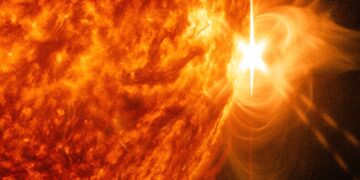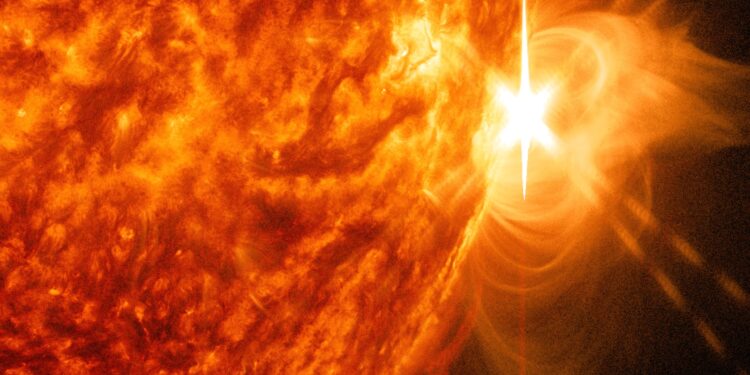On December 8, 2024, the Sun reminded us of its dynamic and powerful nature by unleashing an X2.2-class solar flare from Active Region 3912. While the associated CME is expected to deliver only a glancing blow to Earth on December 11, its potential impacts, combined with our increasing reliance on technology, make it a timely reminder of the importance of monitoring space weather.
What Are Solar Flares and CMEs?
Solar flares are sudden, intense bursts of radiation caused by the release of magnetic energy in the Sun’s atmosphere. They are classified by their intensity into five categories: A, B, C, M, and X, with X-class flares being the strongest. The X2.2 flare from Region 3912 represents a significant event, as X-class flares have the power to disrupt communications and damage satellites if directed at Earth.
Accompanying this flare was a CME, a massive ejection of plasma and magnetic fields from the Sun’s corona. CMEs are often associated with flares and are capable of triggering geomagnetic storms on Earth when their charged particles interact with our planet’s magnetosphere. These storms can cause disruptions to power grids, GPS systems, and even radio communications.
The December 8 Event: Key Details
The X2.2 flare erupted at 09:06 UTC on December 8, peaking rapidly and concluding within 20 minutes. This impulsive flare was associated with a Type II Radio Emission, a phenomenon indicative of a shock wave propagating through the solar corona. The emission’s estimated velocity was 626 km/s, confirming that a CME was produced during the event.
Additionally, a 10 cm radio burst was detected, lasting for three minutes with a peak flux of 870 solar flux units (sfu). These bursts generate significant radio noise, which can interfere with radar, GPS, and other sensitive communication systems. During this flare, radio frequencies over the Southwest Indian Ocean were forecasted to be particularly degraded.
While initial analyses suggested that the CME might be Earth-directed, subsequent modeling showed that Earth would experience only a weak glancing blow from this solar outburst. This impact is expected to coincide with a high-speed solar wind stream from a positive polarity coronal hole, leading to minor geomagnetic disturbances.
The Challenges of Monitoring Solar Activity
Despite advances in technology, monitoring solar activity comes with its own set of challenges. The December 8 event occurred at a time when the Solar Dynamics Observatory (SDO)—a key tool for observing the Sun—was offline due to extensive flooding at the Joint Science Operations Center (JSOC). A chilled-water pipe burst caused significant water damage, disrupting data processing for instruments like the Atmospheric Imaging Array (AIA) and the Helioseismic and Magnetic Imager (HMI).
This incident underscores the fragility of the infrastructure that supports space weather research. While other satellites and ground-based observatories contributed valuable data, the absence of high-resolution imagery from the SDO limited the detail available for studying this flare and CME.
A Weak Glancing Blow on December 11
Forecast models suggest that Earth will encounter a weak glancing blow from the CME on December 11. While the impact is expected to be minimal, the event may couple with a high-speed solar wind stream, potentially leading to isolated periods of geomagnetic activity. Such disturbances are unlikely to cause major disruptions but could enhance auroral activity, providing opportunities for spectacular aurora displays in northern and southern latitudes.
The glancing blow also highlights the Sun’s “poor aim” during this solar cycle, as noted by solar physicist Dr. Tamitha Skov. While the Sun has produced several powerful flares recently, many of the associated CMEs have narrowly missed Earth. This luck, however, is not guaranteed to hold, making continued vigilance essential.
Looking Ahead: Preparing for the Next Solar Cycle Peak
As we approach the peak of Solar Cycle 25, solar activity is expected to increase, with more frequent and intense flares and CMEs. Events like the December 8 flare provide valuable opportunities to refine our understanding of these phenomena and enhance our readiness for future events.
Conclusion
The X2.2 solar flare from Active Region 3912 is a vivid reminder of the dynamic nature of our Sun. While its associated CME is expected to have minimal impact on Earth, the event highlights the importance of space weather monitoring and preparedness. As technology continues to intertwine with our daily lives, understanding and mitigating the effects of solar activity will remain a critical priority.



















